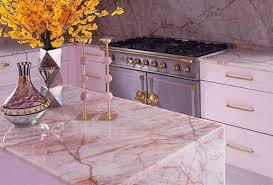Marble, with its timeless elegance and natural beauty, has been a favored material in architectural design for centuries. Among the diverse range of marble varieties, pink marbles stands out as a distinctive choice, captivating the senses with its delicate hues and unique veining patterns. In this article, we will explore the allure of pink marble, its geological origins, applications in architecture, and why it continues to be a cherished choice for interior and exterior design.
The Geological Origins of Pink Marble:
Pink marble, like other types of marble, is a metamorphic rock that undergoes a transformation from limestone through intense heat and pressure beneath the Earth’s surface. The vibrant pink hues are typically attributed to the presence of minerals such as iron oxide or manganese within the marbles. The geological processes create intricate veining and patterns that contribute to the distinctive aesthetic appeal of pink marbles.
Applications in Architecture:
- Interior Elegance: Pink marbles has found a special place in interior design, bringing a sense of luxury and sophistication to various spaces. Commonly used for flooring, countertops, and wall cladding, pink marble adds a warm and inviting ambiance to residential and commercial interiors. The subtle shades of pink range from soft blush tones to deeper, more saturated hues, offering versatility in design applications.
- Decorative Accents: Beyond large surfaces, pink marbles is often utilized for decorative accents and details. From intricately carved fireplace surrounds to elegant staircases and ornate moldings, pink marbles introduces a touch of opulence and refinement. Its ability to be crafted into intricate patterns and designs makes it a favorite among architects and interior designers seeking to create unique focal points within a space.
- Exterior Grandeur: While marbles is commonly associated with interior applications, pink marbles is also utilized for exterior design elements. The use of pink marbles in facades, columns, and outdoor landscaping imparts a sense of grandeur and timelessness. Its durability and resistance to weathering make it a suitable choice for both residential and monumental architectural projects.
The Enduring Appeal of Pink Marble:
- Variety of Hues: One of the captivating aspects of pink marbles is the wide range of hues it encompasses. From subtle and pale pinks to more intense and vibrant shades, the spectrum of colors allows for diverse design possibilities. The versatility in pink marble variations makes it suitable for a range of design preferences and aesthetic themes.
- Veining Patterns: The natural veining patterns found in pink marbles add a layer of visual interest and complexity to their appearance. These intricate patterns, often characterized by graceful swirls and veins, contribute to the uniqueness of each piece of pink marbles. The veins may vary in color, creating a dynamic and organic quality that enhances the overall allure of the material.
- Timeless Elegance: Pink marbles has a timeless and enduring elegance that transcends design trends. Whether used in classical, contemporary, or eclectic settings, its beauty remains relevant and captivating. The delicate color palette and the inherent sophistication of pink marble make it a choice. That can stand the test of time, ensuring a lasting impact on architectural and interior design.
- Cultural Significance: Pink marble has cultural significance in various regions and historical periods. It has been use in the construction of iconic buildings and sculptures, symbolizing luxury, wealth, and artistic achievement. From ancient palaces and temples to modern-day landmarks, pink marble continues to associated with architectural excellence and cultural heritage.
Maintenance and Considerations:
While pink marble exudes beauty, it is essential to consider the maintenance requirements associated with this material. Like all types of marble, pink marble is porous and susceptible to staining. Sealing the surface and adopting regular cleaning practices can help preserve its beauty and longevity. Additionally, consulting with professionals for proper installation and maintenance guidelines is crucial to ensure the optimal performance of pink marble in various applications.
Conclusion:
In the world of architectural design, pink marble remains a captivating choice that seamlessly blends natural beauty with sophisticated elegance. From historical landmarks to contemporary interiors, its timeless allure continues to inspire architects, designers, and homeowners alike. The delicate hues, intricate veining patterns, and cultural significance make pink marble a material. That not only enhances the aesthetics of spaces but also contributes to the narrative of architectural history. As a symbol of enduring beauty, pink marbles stands as a testament to the seamless integration of nature’s artistry into the built environment.

